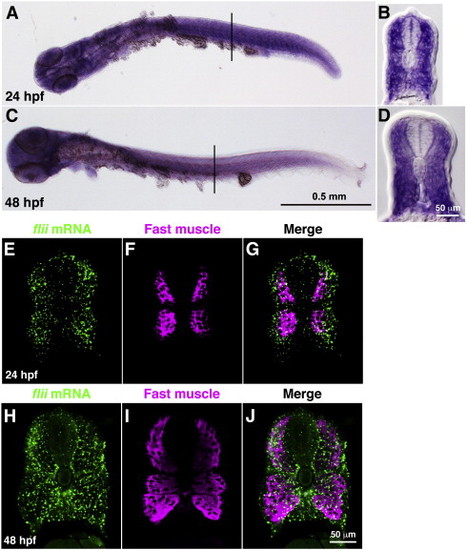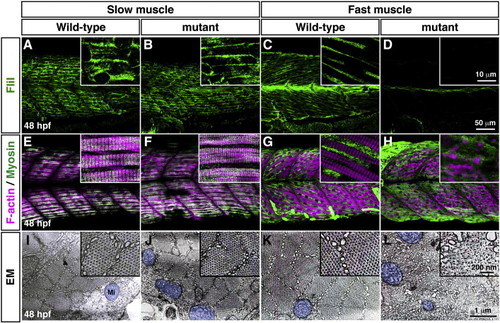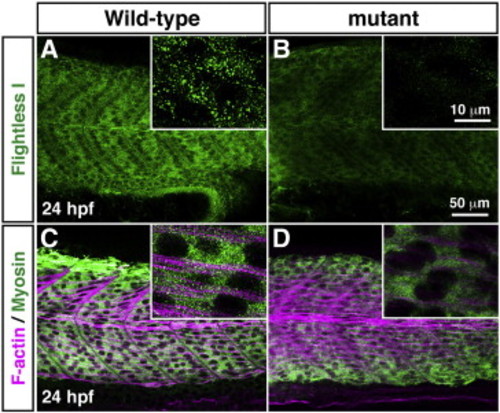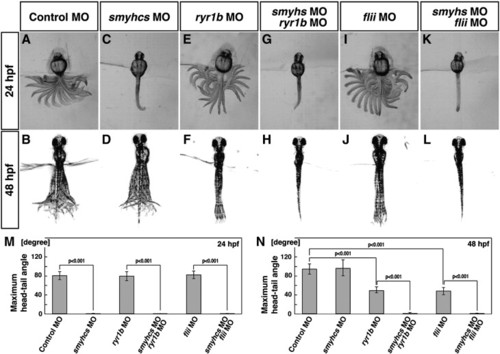- Title
-
Developmental transition of touch response from slow muscle-mediated coilings to fast muscle-mediated burst swimming in zebrafish
- Authors
- Naganawa, Y., and Hirata, H.
- Source
- Full text @ Dev. Biol.
|
mi372 embryos exhibit slower burst swimming and weak muscle contractions. (A-E) Mechanosensory stimulation induced a wild-type embryo (48 hpf) to swim away rapidly. (F-J) Touch induced a mi372 embryo (48 hpf) to swim but only slowly. (K-N) Superimposition of movie frames showing displacement of the trunk and tail. (O) Scheme of quantitative analysis of head-tail angle (θ). (P) Histograms showing the maximum head-tail angles. |
|
flii is expressed in the CNS and muscle. (A–D) In situ hybridization with flii probe. flii appeared to be expressed ubiquitously in whole embryos at 24 hpf (A) and 48 hpf (C). Examination of cross sections confirmed that flii was expressed in muscle tissues (B,D). (E–J) Double labeling with flii mRNA and fast muscle myosin. Expression of flii was observed ubiquitously at both 24 hpf (E) and 48 hpf (H). Anti-fast myosin labeled fast muscle (F,I) but not the superficial slow muscle. In double labeling, flii expression was also seen outside the fast muscle (G,J), suggesting that flii was expressed in both slow and fast muscle. |
|
Actin–myosin fibers are disorganized in flii fast muscles at 48 hpf. (A–D) The expression of FliI protein was assayed with anti-FliI at 48 hpf. FliI protein was expressed in wild-type slow muscle (A), mutant slow muscle (B) and wild-type fast muscle (C) but not in mutant fast muscle (D). (E–H) Double labeling with phalloidin (F-actin) and anti-myosin (slow muscle: F59; fast muscle: MF20) at 48 hpf. Co-labeling of F-actin and slow myosin was seen in wild-type (E) and mutant (F). F-actin was organized in wild-type fast muscle (G) but not in mutant fast muscle (H). (I–L) Electron micrographs of cross-sections of muscle at 48 hpf. Actin and myosin bundles were organized in wild-type slow muscle (I), mutant slow muscle (J) and wild-type fast muscle (K) but not in mutant fast muscle (L). Mitochondria are shaded blue. |
|
Actin–myosin fibers are disorganized in flii fast muscles at 24 hpf. The FliI protein was expressed in wild-type fast muscle (A) but not in mutant fast muscle (B) at 24 hpf. Double labeling with phalloidin (F-actin) and anti-fast myosin (MF20) showed that F-actin was formed in wild-type fast muscle (C). Phalloidin labeling was fainter and less organized in mutant fast muscle (D). |
|
Coilings and burst swimming are mediated by slow and fast muscles, respectively. (A–L) Superimposed movement of the trunk and tail. Control (A), ryr1b (E) and flii (I) morphants exhibited normal coilings at 24 hpf. smyhcs morphants (C), smyhcs-ryr1b (G) and smyhcs-flii (K) double morphants did not move in response to touch at 24 hpf. Control (B) and smyhcs (D) morphants showed normal burst swimming at 48 hpf. The burst swimming was compromised in ry1b (F) and flii (J) morphants at 48 hpf. smyhcs-ryr1b (H) and smyhcs-flii (L) double morphants did not move at 48 hpf. (M,N) Histograms showing the maximum head–tail angles at 24 hpf (M) and 48 hpf (N). |
Reprinted from Developmental Biology, 355(2), Naganawa, Y., and Hirata, H., Developmental transition of touch response from slow muscle-mediated coilings to fast muscle-mediated burst swimming in zebrafish, 194-204, Copyright (2011) with permission from Elsevier. Full text @ Dev. Biol.





